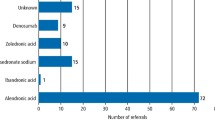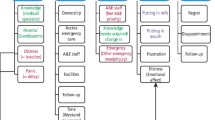Abstract
Introduction Traumatic dental injuries (TDIs) can cause severe and complex dento-alveolar problems. Management of TDIs frequently extends into adulthood; therefore, a clear transitional care pathway (TCP) is important. Failure of this can prevent engagement in adult dental services and negatively influence treatment outcomes.
Aims To assess the availability of TCPs from paediatric and adult specialist care for young people with TDIs.
Materials and methods An anonymous, postal survey was designed and administered to all UK specialists in paediatric dentistry registered with the General Dental Council. Quantitative and qualitative data were gathered.
Results The response rate was 58% (n = 130). Fifty-five percent (n = 72) stated that there was a dental trauma clinic for children within their locality, while only 22% (n = 29) stated that there was a dental trauma clinic for adults. Sixty-nine percent (n = 90) stated that there was no clear TCP within their locality and 41% (n = 37) of these highlighted a need for a TCP. Thematic analysis of opinions with regards to need for a TCP identified three main themes: pathway availability, access to resources and clinician experience. Following a course of treatment for a patient aged 12 years or above, 24% (n = 31) refer to specialist adult services, with 43% (n = 95) continuing to provide follow-up within paediatric dentistry.
Conclusion Follow-up arrangements for young people with TDIs differ across the UK, with inconsistent availability of TCPs. Informal pathways involving referral to multidisciplinary teams may be utilised for follow-up care. Development of a TCP may aid in developing a consistent approach to long-term management of TDIs.
Key points
-
Identifies UK paediatric specialists' opinions on the availability of transitional care pathways for young people who have experienced traumatic dental injuries.
-
Highlights the role of a clear transitional care pathway in preventing a gap in care for young people who have experienced traumatic dental injuries.
-
Identifies the role of the general dental practitioner in the management of young people who have experienced traumatic dental injuries.
This is a preview of subscription content, access via your institution
Access options
Subscribe to this journal
Receive 24 print issues and online access
$259.00 per year
only $10.79 per issue
Buy this article
- Purchase on Springer Link
- Instant access to full article PDF
Prices may be subject to local taxes which are calculated during checkout



Similar content being viewed by others
References
Peterson E E, Andersson L, Sorensen S. Traumatic oral vs non-oral injuries. Swed Dent J 1997; 21: 55-68.
O'Brien M. Children's dental health in the United Kingdom 1993. London: Her Majesty's Stationery Office, 1994.
Cortes M I, Marcenes W, Sheiham A. Impact of traumatic injuries to the permanent teeth on the oral health-related quality of live in 12-14-year old children. Community Dent Oral Epidemiol 2002; 30: 193-198.
Bani-Hani T G, Olegario I C, O'Connell A C. The cost of dental trauma management: A one-year prospective study in children. Dent Traumatol 2020; 5: 526-532.
Glendor U, Halling A, Bodin L, Andersson L Direct and indirect time spent on care of dental trauma: a 20-year prospective study of children and adolescents. Endod Dent Traumatol 2000; 1: 16-23.
Blum R W, Garell D, Hodgman C H et al. Transition from child-centred to adult health-care systems for adolescents with chronic conditions. A position paper of the Society of Adolescent Medicine. J Adolesc Health 1993; 7: 570-576.
Westwood A, Langerak N, Fieggen G. Transition from child-to adult-orientated care for children with long-term health conditions: a process, not an event. S Afr Med J 2014; 104: 310-313.
Department of Health. Transition: getting it right for young people - Improving the transition of young people with long term conditions from children's to adult health services. 2006. Available at https://dera.ioe.ac.uk/8742/2/A9R93BB_Redacted.pdf (accessed October 2020).
Aldiss S, Ellis J, Cass H, Pettigrew T, Rose L, Gibson F. Transition From Child to Adult Care-'It's Not a One-Off Event': Development of Benchmarks to Improve the Experience. J Paediatr Nurs 2015; 30: 638-647.
Crowley R, Wolfe I, Lock K, McKee M. Improving the transition between paediatric and adult healthcare: a systematic review. Arch Dis Child 2011; 6: 548-553.
Campbell F, Biggs K, Aldiss A K et al. Transition of care for adolescents from paediatric services to adult health services. Cochrane Database Syst Rev 2016; DOI: 10.1002/14651858.CD009794.pub2.
NHS England. Commissioning Standard for Dental Specialities - Paediatric Dentistry. 2018. Available at https://www.england.nhs.uk/wp-content/uploads/2018/04/commissioning-standard-for-dental-specialties-paediatric-dentristry.pdf (accessed October 2020).
Levin L, Day P F, Hicks L et al. International Association of Dental Traumatology guidelines for the management of traumatic dental injuries: General introduction. Dent Traumatol 2020; 4: 309-313.
Andreasen J O, Andreasen F M, Andersson L. Textbook and colour atlas of traumatic injuries to the teeth. 4th ed. Copenhagen: Blackwell Munksgaard, 2007.
Glendor U, Halling A, Andersson L, Eilert-Petersson E. Incidence of traumatic tooth injuries in children and adolescents in the county of Vastmanland, Sweden. Swed Dent J 1996; 20: 15-28.
Ravn J J. Dental injuries in Copenhagen schoolchildren, school years 1967-1972. Community Dent Oral Epidemiol 1974; 2: 231-245.
Erika C, Daniela B, Cecilia M, Andrew B. Patients' perspective of a dedicated biologic clinic for inflammatory arthritis. Int J Health Care Qual Assur 2019; 32: 879-886.
Ustun Y, Esen E, Toroglu M S, Akova T. Multidisciplinary approach for the rehabilitation of dentoalveolar trauma. Dent Traumatol 2004; 20: 293-299.
Einy S, Kridin K, Kaufman A Y, Cohenca N. Immediate post-operative rehabilitation after decoronation. A systematic review. Dent Traumatol 2020; 36: 141-150.
Waters L, Patterson B, Scourfield A et al. A dedicated clinic for HIV-positive individuals over 50 years of age: a multidisciplinary experience. Int J STD AIDS 2012; 23: 546-552.
Andersson L, Andreasen J, Day P et al. International Association of Dental Traumatology guidelines for the management of traumatic dental injuries: 2 Avulsion of permanent teeth. Dent Traumatol 2020; 36: 331-342.
NHS England. Commissioning Standard for Restorative Dentistry. 2019. Available online at https://www.england.nhs.uk/publication/commissioning-standard-for-restorative-dentistry/ (accessed December 2020).
Alani A, Austin R, Djemal S. Contemporary management of tooth replacement in the traumatised dentition. Dent Traumatol 2012; 28: 183-192.
Andreasen J O, Borum M K, Jacobsen H L, Andreasen F M. Replantation of 400 avulsed permanent incisors. 2. Factors related to pulpal healing. Endod Dent Traumatol 1995; 11: 59-68.
Andreasen J O, Borum M K, Jacobsen H L, Andreasen F M. Replantation of 400 avulsed permanent incisors. 4. Factors related to periodonal ligament healing. Endod Dent Traumatol 1995; 11: 76-89.
Acknowledgements
The authors would like to thank Dr R. A. Algahmi for her contribution to this study.
Author information
Authors and Affiliations
Corresponding author
Ethics declarations
No funding was received for the completion of this research project. No conflicts of interest were identified.
Rights and permissions
About this article
Cite this article
Morgan, E., Fox, K., Jarad, F. et al. An investigation of transitional care pathways for young people following traumatic dental injuries. Br Dent J (2021). https://doi.org/10.1038/s41415-021-3471-4
Received:
Accepted:
Published:
DOI: https://doi.org/10.1038/s41415-021-3471-4
This article is cited by
-
The paediatric dentistry-restorative dentistry interface
British Dental Journal (2022)
-
Specialist and transitional care provision for amelogenesis imperfecta: a UK-wide survey
British Dental Journal (2022)



